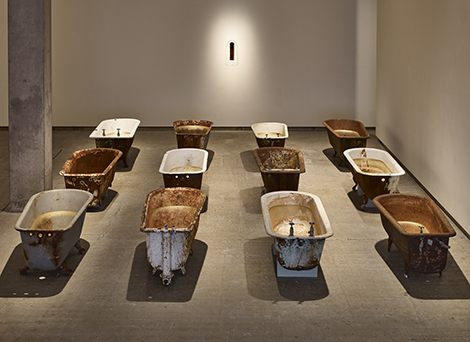The Irish artist Dorothy Cross’ explorations of the links between human activity and the natural world often possess great lyricism and poetic insight. Born in Cork in 1956, she represented Ireland in the 1993 Venice Biennale.
In 2001 she went to live on the edge of Europe on the wild, west coast of Connemara. There she’s concentrated on work that examines the materiality of objects changed by time and history, the effects of touch, and our relationship to the body.

Dorothy Cross, Eye of Shark, 2014, Courtesy the artist and Frith Street Gallery, London, Photography: Stephen White.
In “Eye of Shark,” Cross’ exhibition at Frith Street Gallery, the artist revisits the shark as an emblem of danger, raw nature and chthonic depths. The title work Eye of Shark (2014), commissioned last year by Lismore Castle Arts in Ireland, is a sculptural installation in which a preserved shark’s eye, embedded behind glass in a shrine-like space within the gallery wall, surveys an array of 12 rusted cast-iron bathtubs (which can be seen in numerous Irish fields used as cattle feeders).
The shark’s eye, taken from a fish that few encounter and onto which we project our deepest fears, secretly stares out at us. It is presented as an object of veneration like the thumb-bone of a medieval saint and seemingly presides over the empty tubs. Evocatively laid out like a series of wounded bodies, each antique bath—many without feet or taps—has been covered with gold to the scum-line, where bodily detritus and soap accumulate to leave a trace of human presence. They suggest not only alchemical process, but, like a series of sarcophagi, they evoke the history of ancient burials, where the dead were entombed with their golden artifacts. That they rely so heavily on the visual vocabulary of Anslem Keifer detracts a little from their potency and power.
Cross purveys a dichotomous yet intertwined relationship between culture and nature. In Buoy (2014), a shark skin, its underside leafed in gold, balances atop the apex of an antique easel. An alabaster slab the size of a studio painting sits on the easel as if blank canvas. Bond (2015), a cast bronze, melds the bodies of a small shark and a model submarine. The ergonomics between the two, are, of course, similar and the metaphor obviously one of destruction. The submarine destroys and protects; the shark destroys, yet, in turn, is endangered by man. But the conceptual links between these pieces are rather strained, the images too “arty,” the philosophy too clunky and obvious and not quite strong enough to carry the metaphorical resonances that Cross seems to be reaching towards.
Wormhole i, ii, iii, v 1990 (2015) are four black and white photographs of what looks like a Delphic spring or a carved Roman bath but is, in fact, a natural rock pool on the Isle of Inishmore. These, too, seem to speak of the relationship between culture and nature. This time rather more subtly.


